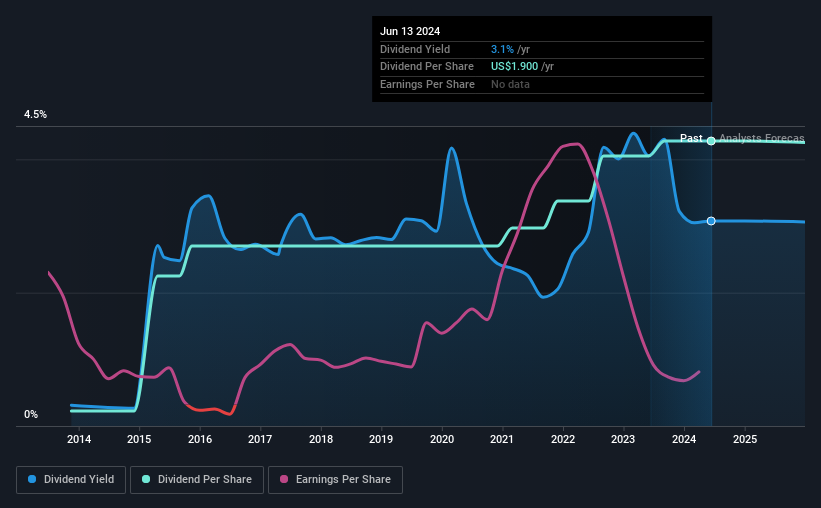- United States
- /
- Insurance
- /
- NYSE:STC
Why It Might Not Make Sense To Buy Stewart Information Services Corporation (NYSE:STC) For Its Upcoming Dividend

It looks like Stewart Information Services Corporation (NYSE:STC) is about to go ex-dividend in the next two days. The ex-dividend date occurs one day before the record date which is the day on which shareholders need to be on the company's books in order to receive a dividend. The ex-dividend date is of consequence because whenever a stock is bought or sold, the trade takes at least two business day to settle. Thus, you can purchase Stewart Information Services' shares before the 17th of June in order to receive the dividend, which the company will pay on the 28th of June.
The company's next dividend payment will be US$0.475 per share, and in the last 12 months, the company paid a total of US$1.90 per share. Looking at the last 12 months of distributions, Stewart Information Services has a trailing yield of approximately 3.1% on its current stock price of US$61.78. If you buy this business for its dividend, you should have an idea of whether Stewart Information Services's dividend is reliable and sustainable. So we need to investigate whether Stewart Information Services can afford its dividend, and if the dividend could grow.
See our latest analysis for Stewart Information Services
Dividends are typically paid out of company income, so if a company pays out more than it earned, its dividend is usually at a higher risk of being cut. Stewart Information Services distributed an unsustainably high 123% of its profit as dividends to shareholders last year. Without more sustainable payment behaviour, the dividend looks precarious.
When a company pays out a dividend that is not well covered by profits, the dividend is generally seen as more vulnerable to being cut.
Click here to see the company's payout ratio, plus analyst estimates of its future dividends.

Have Earnings And Dividends Been Growing?
Companies with falling earnings are riskier for dividend shareholders. If earnings decline and the company is forced to cut its dividend, investors could watch the value of their investment go up in smoke. Readers will understand then, why we're concerned to see Stewart Information Services's earnings per share have dropped 5.6% a year over the past five years. When earnings per share fall, the maximum amount of dividends that can be paid also falls.
Many investors will assess a company's dividend performance by evaluating how much the dividend payments have changed over time. In the last 10 years, Stewart Information Services has lifted its dividend by approximately 34% a year on average. The only way to pay higher dividends when earnings are shrinking is either to pay out a larger percentage of profits, spend cash from the balance sheet, or borrow the money. Stewart Information Services is already paying out 123% of its profits, and with shrinking earnings we think it's unlikely that this dividend will grow quickly in the future.
To Sum It Up
Is Stewart Information Services worth buying for its dividend? Not only are earnings per share shrinking, but Stewart Information Services is paying out a disconcertingly high percentage of its profit as dividends. It's not that we hate the business, but we feel that these characeristics are not desirable for investors seeking a reliable dividend stock to own for the long term. This is not an overtly appealing combination of characteristics, and we're just not that interested in this company's dividend.
Although, if you're still interested in Stewart Information Services and want to know more, you'll find it very useful to know what risks this stock faces. Our analysis shows 2 warning signs for Stewart Information Services and you should be aware of these before buying any shares.
A common investing mistake is buying the first interesting stock you see. Here you can find a full list of high-yield dividend stocks.
New: Manage All Your Stock Portfolios in One Place
We've created the ultimate portfolio companion for stock investors, and it's free.
• Connect an unlimited number of Portfolios and see your total in one currency
• Be alerted to new Warning Signs or Risks via email or mobile
• Track the Fair Value of your stocks
Have feedback on this article? Concerned about the content? Get in touch with us directly. Alternatively, email editorial-team (at) simplywallst.com.
This article by Simply Wall St is general in nature. We provide commentary based on historical data and analyst forecasts only using an unbiased methodology and our articles are not intended to be financial advice. It does not constitute a recommendation to buy or sell any stock, and does not take account of your objectives, or your financial situation. We aim to bring you long-term focused analysis driven by fundamental data. Note that our analysis may not factor in the latest price-sensitive company announcements or qualitative material. Simply Wall St has no position in any stocks mentioned.
Have feedback on this article? Concerned about the content? Get in touch with us directly. Alternatively, email editorial-team@simplywallst.com
About NYSE:STC
Stewart Information Services
Through its subsidiaries, provides title insurance and real estate transaction related services in the United States and internationally.
Reasonable growth potential with adequate balance sheet.


